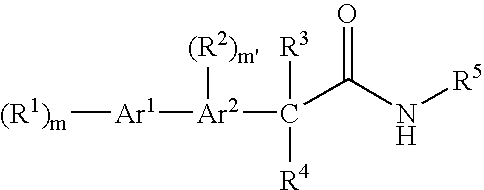Bis-aromatic amides and their uses as sweet flavor modifiers, tastants, and taste enhancers
a technology of aromatic amides and amides, applied in the field of flavor or taste modifiers, can solve the problems of poorly understood biochemical and biochemical basis of taste perception
- Summary
- Abstract
- Description
- Claims
- Application Information
AI Technical Summary
Benefits of technology
Problems solved by technology
Method used
Image
Examples
example 1
2-(4-(Furan-3-yl)phenyl)-N-isobutyl-2-methylpropanamide
[0343]
[0344] 2-(4-Bromophenyl)-N-isobutyl-2-methylpropanamide (Example 1a) (850 mg, 2,85 mmol) was dissolved in 30 ml of toluene, 6 ml of EtOH and 4.5 ml of water followed by 1.38 g (10 mmol) of K2CO3 and 560 mg (5 mmol) of 3-furanboronic acid. The suspension was degassed using argon stream and sonication (30 min). Then 1.16 g (1 mmol) of tetrakis(triphenylphosphine)palladium was added under argon and the mixture was stirred at 80° C. overnight. The solution was dried down on vacuum, diluted with EtOAc and extracted with water. The organic phase was dried over MgSO4 and evaporated on vacuum providing a crude product that was further purified using RP HPLC yielding 300 mg (41%) of the title compound as a white solid. 1H NMR (400 MHz, dDMSO): δ 0.74-0.75 (d 6H), 1.45 (s, 6H), 1.67-1.70 (m,1H), 2.83-2.86 (dd, 2H), 6.94-6.95 (dd, 1H), 7.30-7.32 (m, 3H), 7.54-7.57 (m, 2H), 7.72-7.73 (t, 1H), 8.15-8.16 (t, 1H). MS (M+H, 286).
example 1a
[0345] 2-(4-Bromophenyl)-N-isobutyl-2-methylpropanamide: Methyl 2-(4-bromophenyl)-2-methylpropanoate (1.29 ml, 5 mmol) was added to 30 ml of 1M aq. NaOH and the mixture was stirred at 60° C. overnight. The solution was acidified with 6M aq. HCl (pH 2) and extracted with EtOAc. The organic extract was washed with brine, dried over MgSO4 and concentrated on vacuum. The crude 2-(4-bromophenyl)-2-methylpropanoic acid was coupled without further purification with 2-methylpropan-1-amine (0.5 ml, 5 mmol) in presence of EDC (1.1 g, 5.5 mmol) and HOBt (675 mg, 5 mmol) in 8 ml of DMF at rt overnight. The mixture was dried down on vacuum and extracted with EtOAc and washed with saturated NaHCO3, 10% citric acid and brine. Organic extracts were dried over MgSO4 and concentrated on vacuum to give 2-(4-bromophenyl)-N-isobutyl-2-methylpropanamide as a white solid (1.4 g, 94%). (M+H, 298).
[0346] The compound had an EC50 for activation of a hT1R2 / hT1R3 sweet receptor expressed in HEK293 cell line o...
example 2
N-Isobutyl-2-methyl-2-(4-(4-methylthiophen-3-yl)phenyl)propanamide
[0347]
[0348] Prepared in a similar manner to Example 1 from 2-(4-Bromophenyl)-N-isobutyl-2-methylpropanamide (Example 1a) and 4-methylthiophen-3-ylboronic acid. Yield: 67%. 1H NMR (400 MHz, dDMSO): δ 0.73-0.79 (d, 6H), 1.48 (s, 6H), 1.67-1.74 (m, 1H), 2.23 (s, 3H), 2.84-2.87 (m, 2H), 7.26-7.27 (m, 1H), 7.34-7.40 (m, 5H), 7.43-7.44 (d, 1H). MS(M+H, 316).
[0349] The compound had an EC50 for activation of a hT1R2 / hT1R3 sweet receptor expressed in HEK293 cell line of 0.85 μM.
PUM
 Login to View More
Login to View More Abstract
Description
Claims
Application Information
 Login to View More
Login to View More - R&D
- Intellectual Property
- Life Sciences
- Materials
- Tech Scout
- Unparalleled Data Quality
- Higher Quality Content
- 60% Fewer Hallucinations
Browse by: Latest US Patents, China's latest patents, Technical Efficacy Thesaurus, Application Domain, Technology Topic, Popular Technical Reports.
© 2025 PatSnap. All rights reserved.Legal|Privacy policy|Modern Slavery Act Transparency Statement|Sitemap|About US| Contact US: help@patsnap.com



